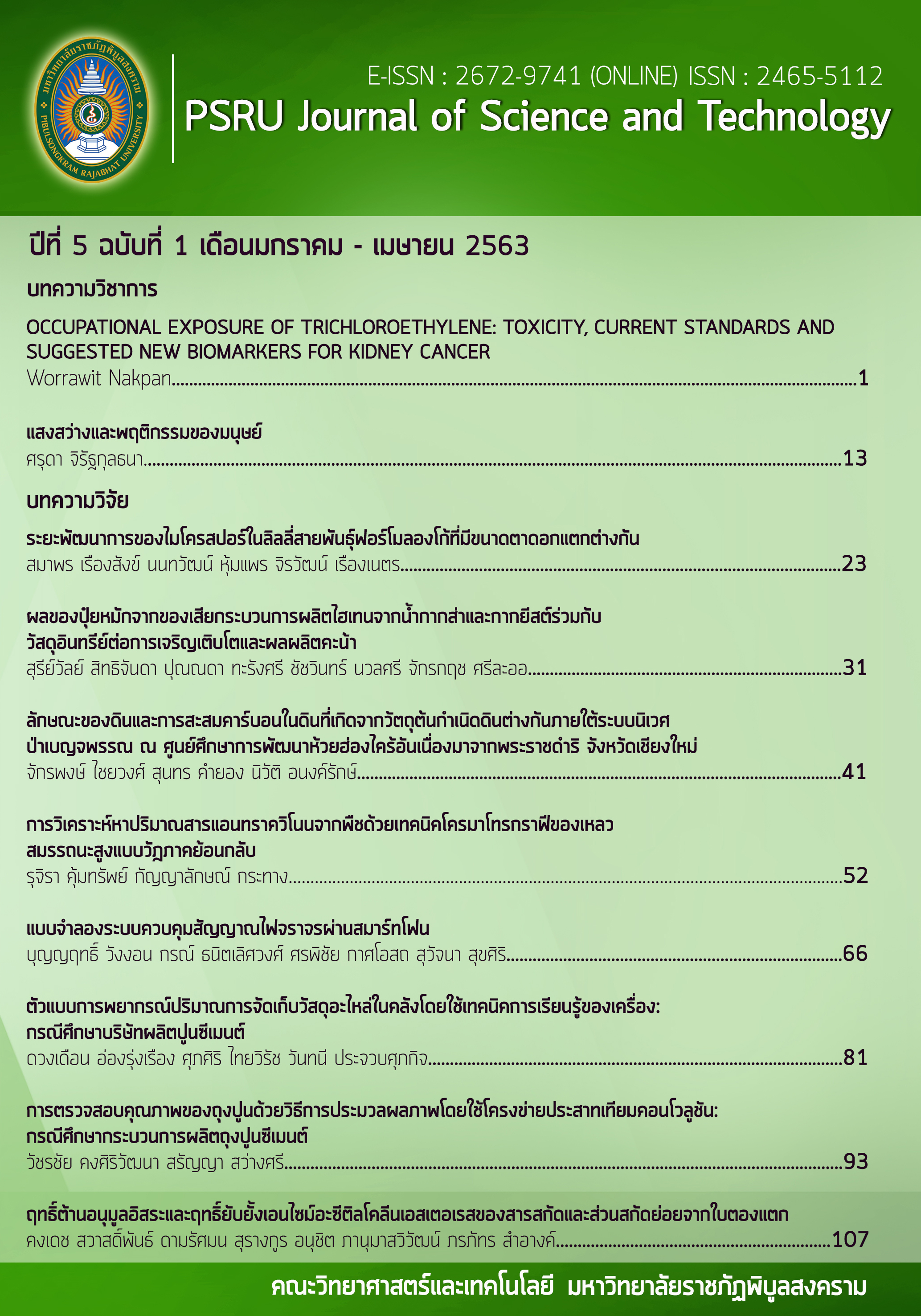ANTIOXIDANT AND ACETYLCHOLINESTERASE INHIBITORY ACTIVITIES OF CRUDE AND FRACTIONATED EXTRACTS FROM TONG TAEK (BALIOSPERMUM SOLANIFOLIUM) LEAVES
Keywords:
Tong taek leaves, Antioxidant activity, Acetylcholinesterase inhibition activityAbstract
Tong taek (Baliospermum solanifolium (Burm.)Suresh) is a local herb in a family of Euphorbiaceae that is important to traditional medicine for treatment or relief of some illnesses. A few reports of the correlation between its antioxidant activity and total phenolic contents were reported. Moreover, the study of anti-acetylcholinesterase (AChE) activity has not been reported previously. Therefore, the objective of this research is to study the antioxidant activity using 2,2-diphenyl-1-picrylhydrazyl (DPPH) method, analyze the total phenolic contents, and investigate the AChE inhibitory activity from Tong taek leaves extracts prepared by a maceration method using an increasing polarity of solvents including hexane, ethyl acetate and methanol, respectively. The crude methanolic extract showed the highest antioxidant activity with an IC50 value of 0.48±0.02 mg/mL and total phenolic contents with a value of 117.82±2.32 mg GAE/g crude extract. For the AChE inhibitory activity testing, it was found that the crude ethyl acetate extract displayed the highest anti-AChE activity with an IC50 value of 62.47±1.47 µg/mL at the concentration of 2000 µg/mL. Then, the crude extracts exhibiting highest biological activities were further separated as fractions or semi-pure compounds by column chromatography to give four fractions (BSM1-BSM4) from the crude methanolic extract which were tested for the antioxidant activity. The fraction BSM2 and BSM4 showed the relatively good antioxidant activity with IC50 values of 1.75±0.02 and 1.89±0.02 mg/mL, respectively. Their total phenolic contents are 72.99±0.04 and 59.43±0.02 mg GAE/g crude extract, respectively. Five fractions (BSEA1-BSEA5) separated from the crude ethyl acetate extract were evaluated on the anti-AChE activity. It was found that both BSEA3 and BSEA5 fractions displayed their anti-AChE activity higher than other fractions with IC50 values of 1.19±0.03 and 1.20±0.07 mg/mL, respectively. These results can be used as further information supported for the isolation of bioactive compounds from B. Solanifolium leaves to be developed as a novel drug candidate for treatment of Alzheimer’s disease.
References
ประเสริฐ อัสสันตชัย. (2556). ปัญหาสุขภาพที่พบบ่อยในผู้สูงอายุและการป้องกัน. (พิมพ์ครั้งที่ 1). กรุงเทพฯ: ยูเนี่ยน ครีเอชั่น.
ภาเกล้า ภูมิใหญ่ และชญานิศา สุพา. (2558). ตัวทำละลายที่มีผลต่อฤทธิ์ต้านอนุมูลอิสระและสารประกอบฟีนอลิกทั้งหมดจากพืชสมุนไพร. ใน มหาวิทยาลัยราชภัฏกำแพงเพชร, การประชุมวิชาการระดับชาติ ครั้งที่ 2 (น. 627-635). กำแพงเพชร: ผู้แต่ง.
มูลนิธิสถาบันวิจัยและพัฒนาผู้สูงอายุไทย (มส.ผส.). (2561). รายงานสถานการณ์ผู้สูงอายุไทย พ.ศ. 2561. นครปฐม: พริ้นเตอรี่.
สำนักงานกองทุนสนับสนุนการสร้างเสริมสุขภาพ (สสส.). (2557). คู่มือการอบรมการดูแลสุขภาพผู้สูงอายุ 18 ชั่วโมง. สระบุรี: โรงพยาบาลส่งเสริมสุขภาพ ศูนย์อนามัยที่ 2 กระทรวงสาธารณสุข.
สิรินทร ฉันศิริกาญจน. (2552). คู่มือยืดอายุสมอง. กรุงเทพฯ: ซีเอ็ดยูเคชั่น.
Andarwulan, N., Batari, R., Sandrasari, D.A., Bolling, B. & Wijaya, N. (2010). Flavonoid content and antioxidant activity of vegetables from Indonesia. Food chemistry, 121(4), 1231-1235.
Anonymous. (1988). The Wealth of India: A dictionary of Indian Raw Materials and Industrial Products. Raw materials, Vol A. Publication and Information Directorate, New Delhi: India.
Biju, J., Sulaiman, C.T., Sadashiva, C.T., Satheesh, G. & Reddy, V.R.K. (2013). In vitro screening for acetylcholinesterase inhibition of Baliospermum montanum, Humboldtia brunonis Wall. var. raktapushpa and Pittosporum viridulum. Journal of Applied Pharmaceutical Science, 3(12), 63-65.
Damsud, T., Chanwun, T., Srimek, N. & Songsaneng, S. (2017). Antioxidant and α-glucosidase inhibitory
activities of young Jackfruit (Artocarpus heterophyllus) extract. KKU Science Journal, 45(3), 543-550.
Desai, P.V., Wadekar, R.R., Kedar, G.H. & Patil, K.S. (2008). Free radical scavenging activity of aqueous extract of roots of Baliospermum montanum Muell-Arg. International Journal of Green Pharmacy, 2, 31-33.
Doraiswamy, P.M., Leon, J., Cummings, J.L., Marin, D. & Neumann, P.J. (2002). Prevalence and impact of medical comorbidity in Alzheimer's disease. The Journals of Gerontology Series A Biological Sciences and Medical Sciences, 57, 173–177.
Ellman, G.L., Courtney, K.D., Andres Jr., V. & Featherstone, R.M. (1961). A new and rapid colorimetric determination of acetylcholinesterase activity. Biochemical Pharmacology, 7, 88–95.
Giacobini, E. (2002). Long-term stabilizing effect of cholinesterase inhibitors in the therapy of Alzheimer’ disease. Journal of neural transmission. Supplementum, 62, 181–187.
Halliwell, B. (1989). Free radicals in biology and Medicine. Oxford: Clarendon Press, 543.
Holmes, C., Boche, D., Wilkinson, D., Yadegarfar, G., Hopkins, V. & Bayer, A. (2008). Long-term effects of Aβ42 immunisation in Alzheimer's disease: follow-up of a randomised, placebo-controlled phase I trial. The Lancet, 372, 216–223.
Inta, T., Saelee, A., Sam-ang, P., Srisayam, M., Phalee, W. & Chodnakarin, A. (2019). Inhibition Staphylococcus aureus and antioxidant activity of crude extract from rested celosin (Celosia cristata). PSRU Journal of Science and Technology, 4(2), 34-42.
Kitphati, W., Wattanakamolkul, K., Lomarat, P., Phanthong, P., Anantachoke, N., Nukoolkarn, V. & Bunyapraphatsara, N. (2011). Anticholinesterase activity of constituents of essential oils from Thai medicinal plants. Journal of Physiological and Biomedical Sciences, 24, 58–67.
Mali, R.G., Mahajan, S.G. & Mehta, A.A. (2006). Antimicrobial activity of Baliospermum montanum Muell-Arg leaves. Planta Indica, 2, 13-14.
Mali, R.G. & Wadekar, R.R. (2008). In vitro Anthelmintic activity of Baliospermum montanum Muell.Arg roots. Indian Journal of Pharmaceutical Sciences, 70, 131-133.
Melo, J.B., Agostinho, P. & Oliveira, C.R. (2003). Involvement of oxidative stress in the enhancement of acetylcholinesterase activity induced by amyloid beta-peptide. Journal of Neuroscience Research, 45, 117–127.
Ogura, M., Koike, K., Cordell, G.A. & Farnsworth, N.R. (1978). Potential anticancer agents VIII. Constituents of Baliospermum montanum (Euphorbiaceae). Planta Medica, 33, 128-143.
Roseiro, L.B., Rauter, A.P. & Serralheiro, M.L.M. (2012). Polyphenols as acetylcholinesterase inhibitors: structural specificity and impact on human disease. Nutrition and Aging, 1, 99–111.
Su, F., Bai, F. & Zhang, Z. (2016). Inflammatory cytokines and Alzheimer’s disease: A review from the perspective of genetic polymorphisms. Neuroscience Bulletin, 32, 469–480.
Sun, A.Y., Wang, Q., Simonyl, A. & Sun, G.Y. (2010). Resveratrol as a therapeutic agent for neurodegenerative diseases. Molecular Neurobiology, 41, 375–383.
Tan, P.P., Yuan, H.H., Zhu, X., Cui, Y.Y., Li, H., Feng, X.M., Qiu, Y., Chen, H.Z. & Zhou, W. (2014). Activation of muscarinic receptors protects against retinal neurons damage and optic nerve degeneration in vitro and in vivo models. CNS Neuroscience & Therapeutics, 20(3), 227–236.
Vittaya, L., Khongsai, S., UI-ENG, J. & Leesakul, N. (2017). Phytochemical screening, phenolic content and free radical scavenging activity of Baliospermum solanifolium (Burm.) Suresh stem and leaf extracts. Thai Journal of Botany, 1, 97-105.
Downloads
Published
How to Cite
Issue
Section
License
กองบรรณาธิการขอสงวนสิทธิ์ในการปรับปรุงแก้ไขตัวอักษรและคำสะกดต่างๆ ที่ไม่ถูกต้อง และต้นฉบับที่ได้รับการตีพิมพ์ในวารสาร PSRU Journal of Science and Technology ถือเป็นกรรมสิทธิ์ของคณะวิทยาศาสตร์และเทคโนโลยี มหาวิทยาลัยราชภัฏพิบูลสงคราม และ
ผลการพิจารณาคัดเลือกบทความตีพิมพ์ในวารสารให้ถือมติของกองบรรณาธิการเป็นที่สิ้นสุด







